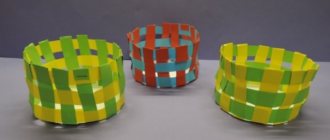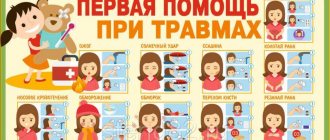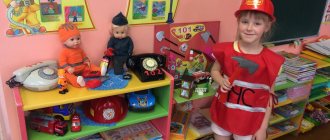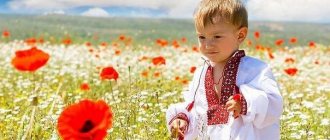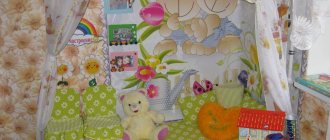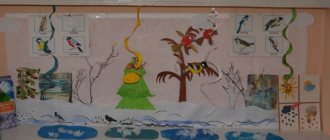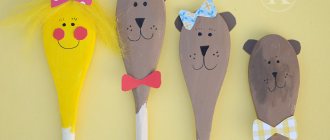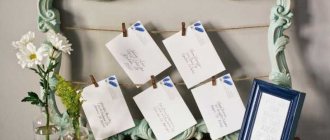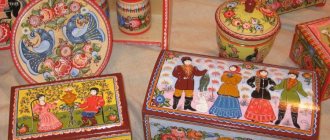Explanation of traffic rules in kindergarten through crafts
The child, creating crafts and playing with them, has fun getting acquainted with traffic rules. Play is a basic activity for preschoolers. Through it, the children learn about the environment. Bright layouts are created independently or in groups, quietly studying and consolidating knowledge of traffic rules:
- names of parts of the street, their purpose;
- traffic light color function;
- road markings and their meanings;
- correct behavior as a driver, passenger, pedestrian;
- traffic controller function;
- road signs.
Fun activity
The tasks become more complicated from the younger to the older groups of the garden. Junior groups create simple appliqués from geometric blanks cut out by the teacher. The essence of the technique: leaves of the appropriate shape and color are carefully glued into the drawn figures. For example, multi-colored circles are glued to the right places on an image of a traffic light.
Children from the middle groups of preschool educational institutions cut out simple silhouettes on their own according to the teacher’s template, select the material to their liking (natural, purchased, waste), and follow the step-by-step instructions. At this age, more complex appliqué techniques are used: cut-off, modular. Scrap crafts are images filled with scraps of colored paper of different sizes.
The finished application resembles a mosaic. First, they draw a base image, which will be filled with pieces of material. Tear or cut the paper with their own hands (kids do this with their fingers, without using dangerous tools).
The modular application for traffic rules is often used in the older group. The essence of the method: parts are folded out of paper and assembled into one figure. This is how they create traffic lights with flowers, pedestrians, and cars.
Note! The middle group works according to instructions, under the supervision of the teacher.
Students from 4 years old can prepare elements of three-dimensional construction sets from available materials and assemble them. The figures created by the group are placed in the form of a game layout: streets with roads, houses, traffic lights, cars. For example, a traffic controller or a traffic light is made from several boxes covered with colored sheets of paper. The teacher and parents can help the baby.
Preschoolers aged 6-7 years rarely use instructions. The guys show their imagination and select the most suitable material. They implement the idea using previously acquired skills in drawing, modeling from plasticine, appliqué, and design.
The goals of creating crafts for kindergarten on the topic “Road Rules”:
- formation of knowledge of traffic rules;
- improving fine motor skills;
- fostering independence and accuracy;
- enrichment of the dictionary with traffic rules terms;
- development of imaginative thinking.
These goals can be achieved through creative work.
Summary of an open lesson on application in the senior group “Be careful pedestrian, here is a road crossing”
Goal: to develop a consciously correct attitude towards compliance with traffic rules as a pedestrian.
Tasks:
1. Reinforce the rules of the road, teach how to apply knowledge previously acquired in practical activities.
2. Activate children’s thinking through:
— developing the ability to define tasks based on the problem posed,
- developing in children the ability to create a conceived product,
— improving the level of accumulated practical skills (creating a street layout, adding details to it).
3. Activate children’s speech through developing the ability to organize their actions.
4. Develop independence and the ability to interact with peers.
5. Strengthen the ability to correctly compose images from details.
6. Practice gluing parts carefully.
7. Cultivate in children an interest in the environment and applications.
8. Develop imagination and sense of composition.
Preliminary work with children: looking at illustrations of cars, guessing riddles “types of transport,” discussing problem situations “dangers on the road.”
With parents: invite parents to discuss and follow traffic rules for pedestrians while walking with their children.
Materials: magnetic board, pictures depicting transport, tinted landscape sheets F A4, blanks of colored paper with an outline of: cars, wheels, traffic lights, zebras; scissors, glue, napkins.
Types of children's activities in GCD:
Communicative.
Productive.
Gaming.
Motor.
Cognitive.
Integration of educational areas: “Cognition”, “Socialization”, “Communication”, “Artistic creativity”, “Physical education”.
Part 1 – Introductory
- Guys, today we have guests, let’s say hello to them and smile at them, and now let’s smile at each other.
“Come to me, look at the board,” please tell me what is shown in the pictures? (children's answers)
-I know that you love to play, and now I want to play a game with you. The game “Raise your hand, those who...” is played.
Raise your hand, those who like to play with cars?
Raise your hand, those who come to kindergarten on foot?
Raise your hand, those who come to kindergarten by bus?
Raise your hand, those who are brought to kindergarten by car?
Raise your hand, those whom your mother brought today?
Raise your hand, those whom dad brought today?
Raise your hand, those who come to kindergarten alone, without adults?
-Now you are all in a group, which means that you all come to kindergarten together with adults, with mom or dad, with grandparents. Why do you think? (children's answers). That's right, you and I know that the street is a place where you have to be very careful so that nothing bad happens.
Creative techniques for learning the rules of the road
The selection describes effective, inexpensive types of crafts. These are techniques that kids can understand and use accessible materials.
Craft games
Applications
Application according to traffic rules is an important method in the preparatory group. Through this technique, children are introduced to the structure of traffic lights, the meanings of road signs, and street layouts. To build a paper traffic light, prepare:
- white and colored sheets;
- markers;
- rulers;
- pencils;
- glue;
- scissors (for older preschoolers).
Work program for preparing preschool children for school
The basis of the craft is a blank sheet with a drawn rectangle and three circles inside. Paper figures are glued on top in the correct order. The rectangle can be shaded or painted over. At the end of the work, the little master explains the order of the colors and what they mean. The student uses a ruler or draws lines with his naked hand, improving concentration and fine motor skills.
Important! Before classes, a conversation is held about safety rules.
Modeling from plasticine
Three-dimensional figures are molded from plasticine and spread over the shape. This is how road signs are made. Use:
- stencils;
- rolling board;
- stacks;
- white plasticine.
Step-by-step instruction:
- Knead the plasticine with your hands.
- Pinch off pieces.
- Attach them to the base and rub.
- Fill in the signs by smearing white plasticine over the template.
- Plasticine that has gone beyond the contour is removed in stacks.
The group makes the same sign to consolidate knowledge about it.
Drawings
Younger preschoolers in kindergarten draw scenes based on traffic rules, objects, and explain them. Children, if desired, depict signs, zebras, cars on the road. Drawings can be used as a basis for game layouts. In this case, they are supplemented with structures, toys, figures made of plasticine and other materials. In the kindergarten, in warm weather, images are painted with crayons outside in a designated area. Older children invent and draw correct and incorrect situations and comment on them.
Crafts from cereals and pasta
Cars, houses, plants, and animals are made from pasta of various shapes. They choose interesting types: horns, shells, straws, long noodles. Purchase products in natural colors and with dyes. Prepare a flat, roomy base on which the figures will be fixed. It could be a board, cardboard. In groups, the children create a didactic panel in the form of a town. Multi-colored cereals are used as a material for modeling and drawing. Dry porridge is sprinkled on the “streets” and “roads” of the compositions.
Master class on making a pasta truck:
- Prepare liquid glue, pasta in the form of horns, short tubes, flowers, “ruffles”.
- Assemble the “cabin”: glue 3 tubes together to form a rectangle. Repeat the action.
- The rectangles are glued together with the flat side.
- On one side of the product, two more are attached to the lower tube, one after the other.
- Glue another rectangle from 6 of the same pasta. It is glued to the back of the cabin. This is the body.
- The body walls are made from “ruffles”.
- Wheels—horns—are attached to the bottom of this structure.
- There are 2 “flowers” installed in front of the body - headlights.
Note! The child, analyzing the shape and structure of cars, comes up with his own versions of pasta technology.
Organizing a crafts exhibition in kindergarten
Exhibitions of children's creativity are mandatory educational events. Their goals:
- improving the baby's self-esteem;
- developing a sense of responsibility;
- formation of taste;
- strengthening the connection between children and parents through joint creativity;
- familiarizing participants with each other’s creativity, stimulating healthy competition.
Exhibition on traffic rules
Exhibitions are joint celebrations where the entire school and parents are invited. They are held several times a year. Families take pictures and communicate. The best exhibits are sent to a permanent exhibition.
Diagnostics of creative development of preschool children
During the organization of the event:
- set a date;
- choose a topic;
- notify children;
- Invitation leaflets are prepared upon request.
To summarize, posters are prepared with photographs of the works and masters.
Important! During the exhibition, discipline is controlled by the teacher. Crafts on traffic rules for parents and kids
The selection includes master classes on creating game panels on various topics. They will serve as an illustration of traffic rules.
Crossroads
You will need:
- toy cars;
- rulers;
- pencils, felt-tip pens;
- glue;
- scissors;
- cardboard;
- multi-colored paper;
- base from the bottom of a cardboard box.
Stages of work:
- They construct buildings from boxes covered with colored sheets. You can make a school, a residential building, a store.
- They glue and draw windows and roofs.
- Cut the white sheet into strips 5cm wide. Glue them onto black cardboard to create a zebra.
- Cut off two long white stripes and 8 short ones. They are glued to gray cardboard - this is a road with markings.
- They are making trees, 4 traffic lights (on each side of the crossing).
- The crafts are attached to the base and the cars are placed.
You can use a real intersection known to your child as a model. Thinking through an idea is no less important than implementing it.
DIY crossroads
Parking
You will need:
- a pair of hard cardboard boxes;
- glue;
- scissors;
- blue, white paper;
- a simple pencil;
- cars, helicopter.
Stages of work:
- They create a three-story base: 3 identical sheets (from boxes) are attached horizontally to another vertical sheet. Make sure that the distance between floors is the same.
- A long, wide ribbon in the shape of a semicircle is cut out of cardboard. It should connect the 1st and 3rd floors. This road is connected to the lower floor on the right, and to the upper floor on the left.
- On the platform they place a cardboard tube with a “lid” - this is a place for a helicopter.
- Markings are made by gluing white stripes (spaces for cars) and blue tapes with arrows (traffic indicators).
- Cars are being arranged.
The process is discussed with the child so that the child sees the logic of what is happening.
DIY application “Traffic light” for children of the senior preparatory group
Application “Traffic light” from scrap materials for children from 5 years old.
Master class with step-by-step photos. Author: Rostislav Abdulloev, 6 years old, student of the Meshchovsky Social Rehabilitation Center for Minors, Meshchovsk Head: Tatyana Anatolyevna Shilkina, teacher of the Meshchovsky Social Rehabilitation Center for Minors, Meshchovsk. Meshchovsk, Kaluga region. Description: The master class is intended for teachers, parents with children of preschool and primary school age. Purpose: The work can be used in story games to familiarize children with traffic rules.
Goal: making a “Traffic Light” applique from improvised materials. Objectives: - learn to compose an image of an object from several parts; - develop fine motor skills of fingers; - teach careful gluing, use glue and brush correctly; - cultivate interest in working with different materials. Materials and tools required for work: colored paper, scissors, household sponge, PVA glue, pencil, cardboard, bullets, corrugated cardboard.
Templates
STRICT TRAFFIC LIGHT The traffic light told us sternly: - Be careful, there is a road here! Don't play, don't be naughty, just stand and watch! The red light came on at the top: Red light is always dangerous! A tractor and a tram are coming, Hey, driver, don’t yawn! White zebra crossings: Pedestrians wait calmly. The traffic light told us clearly - Red light - it’s dangerous to go! The traffic light winked at us, He blinked his yellow eye. Yellow light and red light: Still no road! The traffic light is on guard, At night it doesn’t even sleep.
Progress :
From colored paper we cut out the details of the traffic light according to the template.
We glue them onto cardboard.
We outline the “eyes” of the traffic light.
We begin to lay out the “eyes” using bullets and PVA glue. We decorate the finished application with a frame made of corrugated cardboard.
Here is another option for performing the “Traffic Light” application. We cut out the traffic light parts according to the template, glue them onto cardboard, and mark the “eyes” of the traffic light.
Take a household dishwashing sponge of three colors (red, yellow, green) and tear it into small pieces
We lay out the “eyes” of the traffic light, gluing the sponge with PVA glue. We arrange the finished application in a frame.
These are the traffic lights we got!
Thank you for your attention!
We recommend watching:
DIY traffic light applique for older children. DIY paper applique for kindergarten. Traffic light Construction from waste material. Traffic light. Master class for children 5-6 years old DIY paper traffic light model for children with step-by-step photos
Similar articles:
Traffic light - do-it-yourself tablet. Master Class
